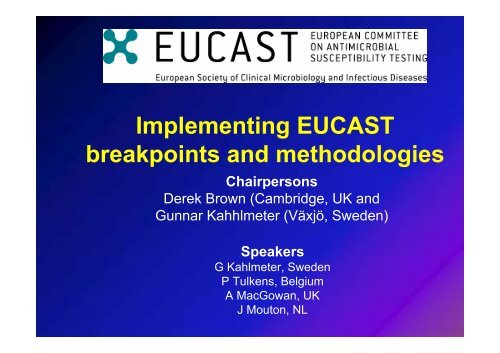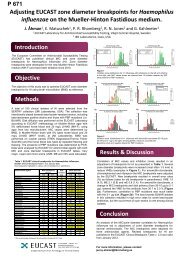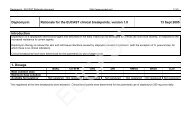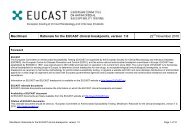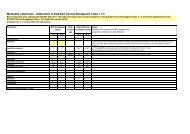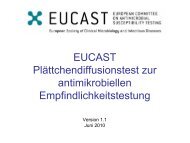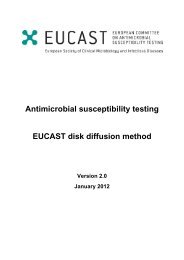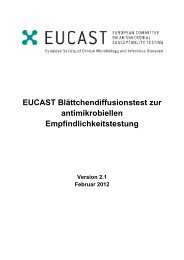Implementing EUCAST breakpoints and methodologies
Implementing EUCAST breakpoints and methodologies
Implementing EUCAST breakpoints and methodologies
You also want an ePaper? Increase the reach of your titles
YUMPU automatically turns print PDFs into web optimized ePapers that Google loves.
Implementation of <strong>EUCAST</strong> <strong>breakpoints</strong><strong>and</strong> impact on resistance surveillanceGunnar KahlmeterVäxjö, SwedenGunnar.kahlmeter@ltkronoberg.se
<strong>EUCAST</strong> Tasks• Determine clinical <strong>breakpoints</strong> for new <strong>and</strong> existingantimicrobials for bacteria <strong>and</strong> fungi.• Determine epidemiological cut-off values (ECOFFs) for allantimicrobials for bacteria, for fungi.• Provide European st<strong>and</strong>ardised <strong>and</strong> harmonised methods forAST of bacteria <strong>and</strong> fungi.• Education of laboratory staff (national <strong>and</strong> internationalworkshops; ESCMID, ECCMID, ECDC)• Liaise with European regulatory authorities <strong>and</strong> NGOs <strong>and</strong>with international groups involved in AST <strong>breakpoints</strong> <strong>and</strong>methodology.
<strong>EUCAST</strong> defines test systems<strong>and</strong> determines <strong>breakpoints</strong>:Clinical <strong>breakpoints</strong>Epidemiological cut-off values• for MIC determination• for AST automatic devices• for disk diffusion
2000S/I-<strong>breakpoints</strong>I/R-<strong>breakpoints</strong>CLSI
2007S/I-<strong>breakpoints</strong>I/R-<strong>breakpoints</strong><strong>EUCAST</strong>CLSI
<strong>EUCAST</strong> <strong>and</strong> existing antimicrobials• Aminoglycosides √• Carbapenems & aztreonam √• Cephalosporins iv √• Cephalosporins oral (finalised May 2009)• Fluoroquinolones √• Glycopetides √• Macrolides <strong>and</strong> lincosamides √• Penicillins √• Tetracyclines √• Miscellaneous antimicrobials √• Antifungal drugs (flu- <strong>and</strong> voriconzole) √
<strong>EUCAST</strong>– breakpoint committee for new drugs throughEuropean Medicines Agency (EMEA)• Daptomycin √• Tigecycline √• Garenoxacin (√)• Doripenem √• New cephalosporin (ongoing)• Glycopeptides (3 ongoing)• Fluoroquinolone (1 ongoing)• Diaminopyrimidine (1 ongoing)• Extensions of indications
<strong>EUCAST</strong> Subcommittee on AnaerobesChair Arne Rodloff• Determined which antimicrobials should have<strong>breakpoints</strong> for Gram-negative <strong>and</strong> Gram-positiveanaerobes• Breakpoints for anaerobes• Investigating methodological aspects on AST ofanaerobes
<strong>EUCAST</strong> Subcommittee on Expert RulesChair Rol<strong>and</strong> Leclercq• Intrinsic resistance tables• Unusual phenotypes tables• Interpretive reading of AST tables• Finalised 2008• Revised during 2009• ”Computerized” in 2009
Consultation with expert groups• Neisseria spp (finalised)• Anaerobes (ESGARAB, ongoing)• Helicobacter pylori (EHSG, ongoing)• Clostridium difficile (ESGCD, ongoing)• Campylobacter (VetCast, ongoing)• Listeria monocytogenes• …
Anaerobes with ESGARABJPEG Image
C. difficile with ESGCD
Campylobacter with Veterinarian microbiology
Participants in UKNEQAS for Microbiology (2008)Derek Brown, Educational Workshop 5, ECCMID 2009Austria 43Belgium 4Croatia 6Finl<strong>and</strong> 23Germany 1Greece 16Irel<strong>and</strong> 45Italy 124Netherl<strong>and</strong>s 18Pol<strong>and</strong> 1Portugal 52Romania 2Sweden 28Switzerl<strong>and</strong> 24United Kingdom 278Other 82
Breakpoint guidelines used by participants inUKNEQAS 2009Derek Brown, Educational Workshop 5, ECCMID 2009GuidelineNumber (%) labsCLSI 368 (53.7)BSAC (UK) 190 (29.6)SRGA (Sweden) 36 (4.8)NWGA (Norway) 6 (0.6)CRG (Netherl<strong>and</strong>s) 5 (0.7)<strong>EUCAST</strong> 4Other 43TOTAL 674
Methods used by participants in UKNEQAS 2008Derek Brown, Educational Workshop 5, ECCMID 2009MethodNumber (%) labsDisk diffusion 352 (51)Automated (CLSI) 240 (31)MIC 26 (4)Breakpoint 23 (3)Other/not stated 81 (11)Total 672
<strong>EUCAST</strong> <strong>and</strong> CLSI <strong>breakpoints</strong>Group of organismsare different!No. of<strong>breakpoints</strong>Same breakpoint(s) forS <strong>and</strong> R S REnterobacteriaceae 36 0 3 3Pseudomonas 18 1 (IMI) 5 2Acinetobacter 11 1 (COL) 4 2Staphylococci 31 4 5 2Enterococci 14 0 2 3Streptococci 25 2 5 2S. pneumoniae 29 3 1 5H. influenzae 27 0 3 0
<strong>EUCAST</strong>- <strong>and</strong> CLSI-<strong>breakpoints</strong> are different• The processes for determining <strong>breakpoints</strong> are nowsimilar but <strong>EUCAST</strong> has systematically <strong>and</strong> recentlyreviewed all <strong>breakpoints</strong>.• Structure <strong>and</strong> organisation of committee.• The role of industry (consultative vs. part of decisionprocess).• The number of committee meetings per year (5 vs. 2).• The relation between committee <strong>and</strong> regulatoryauthorities.
AntimicrobialE.coli, Klebsiella, Proteus<strong>EUCAST</strong> vs. CLSI<strong>EUCAST</strong>S≤/R>(mg/L)CLSIS≤/R>(mg/L)Ampicillin 8 / 8 8 / 16Cefotaxime 1 / 2 8 / 32Ceftazidime 2 / 8 8 / 16Cefuroxime 8* / 8 4 / 16Imi-/Meropenem 2 / 8 4 / 8Ciprofloxacin 0.5 / 1 1 / 2Gentamicin/Tobra 2 / 4 4 / 8Amikacin 8 / 16 16 / 32Trimethoprim 2 / 4 8 / 8Nitrofurantoin 64 / 64 32 / 64*Increased from 4 to 8 mg/L to avoid dividing the wild type MIC distribution
Streptococcus pneumoniae<strong>EUCAST</strong> vs. CLSIAntimicrobial<strong>EUCAST</strong>S≤/R>(mg/L)CLSIS≤/R>(mg/L)Benzylpenicillin Meningitis 0.064 / 0.064 0.064 / 0.064Benzylpenicillin Pneumonia 0.064/ 2* 2 / 4**Penicillin V PcG 0.064 / 0.064 0.064 / 1Ampi/Amoxicillin 0.5 / 2 2 / 4Cefotaxime 0.5 / 2 1 / 2Moxifloxacin 0.5 / 0.5 1 / 2Erythromycin 0.25 / 0.5 0.25 / 0.5Azitromycin 0.25 / 0.5 0.5 / 1*MIC-related (0.125 – 2 mg/L) variable dosing for pneumonia**High dose for pneumonia
Why European <strong>breakpoints</strong> in Europe?• <strong>breakpoints</strong> for European minimum <strong>and</strong> maximum dosages• based on EMEA approved indications <strong>and</strong> outcome evaluation,Pk/Pd, multiple MIC distributions, <strong>and</strong> modern principles ofdetermining <strong>breakpoints</strong>• accepted by European regulatory authorities (EMEA, ECDC) <strong>and</strong>the only <strong>breakpoints</strong> in European SPCs• European (ECDC) ”case definitions” for antimicrobial resistancesurveillance• harmonised st<strong>and</strong>ards for national <strong>and</strong> European strategies• rationale behind decisions transparent <strong>and</strong> published• independent of commercial interests• reviewed at intervals: with every new member of class <strong>and</strong> onthe initiative of a) EMEA, b) the profession, c) Company• in the public domain free of charge
Implementation• MIC-testing of any kind √• National systems from France, UK, Sweden √• Phoenix √• Vitek2, MicroScan – ongoing• Disk diffusion – ongoing
<strong>EUCAST</strong> Disk Diffusion TestMethods, QC from autumn 2009Breakpoints from late 2009
<strong>EUCAST</strong> disk diffusion testNon-fastidious organisms• Mueller-Hinton• Inoculum 0.5 McFarl<strong>and</strong>• Incubation 18 +/-2 h• Disk strengths as CLSI exceptgentamicin 10µg, tobramycin10µg, cefotaxime 5µg,ceftazidime 10µg.• QC strains <strong>and</strong> referenceranges as ISO <strong>and</strong> CLSI +three more strainsStreptococci, H.influenzae, etc• MH + 5% defibrinated horseblood <strong>and</strong> 20 mg β-NAD forstreptococci, pneumococci <strong>and</strong>H. influenzae• Inoculum 0.5 McFarl<strong>and</strong>• Incubation 18 +/-2 h• Disk strengths as CLSI exceptgentamicin 10µg, tobramycin10µg, cefotaxime 5µg,ceftazidime 10µg.• QC strains <strong>and</strong> reference rangesas ISO <strong>and</strong> CLSI + three morestrains
E. coli ATCC 25922
S. pneumoniae ATCC 49619 H. influenzae NCTC 8468MH + 5% defibrinated horse blood <strong>and</strong> 20 mg/L β-NADGrows streptococci <strong>and</strong> H. influenzae
<strong>EUCAST</strong> MIC- <strong>and</strong> Zonediameter distribution website>19 000 MIC distributionsIncreasing number of zone diameter distributionsQC ATCC strains (MIC, Zone diameter)>22 000 hits since ECCMID 2007
<strong>EUCAST</strong> breakpoint tables under development (MIC <strong>and</strong> Zone diameter)
<strong>EUCAST</strong> QC tablesTargets NOT in italics are from ISO <strong>and</strong>/or CLSI recommendations
National strategies <strong>and</strong> jointdecisions on AST are needed!Countries are encouraged to formNational Antimicrobial Committee
National Antimicrobial Committeestasks• Antimicrobial susceptibility testing– Strategy at national level– Implementation of <strong>breakpoints</strong> <strong>and</strong> methods– Education through regular national workshops– Liaison <strong>and</strong> consultation with <strong>EUCAST</strong>– Liaison with groups involved in AMR-surveillance(ECDC, EARSS, ….).–QA• Antimicrobial Policies• Antimicrobial Resistance Surveillance• Antimicrobial Consumption <strong>and</strong> Policies
NAC = existing breakpoint committeesNAC = existing antibiotic/AST committeesNACNACNACNACNACNACNACNACNACNACNACNACNACNAC
European Network of AntimicrobialCommittees=The future <strong>EUCAST</strong> General Committee.
<strong>EUCAST</strong> <strong>breakpoints</strong>available for routine testing1st of January 2010:MIC determination – broth, agar dilution or gradientmethodsAutomated AST (2009 – 2010)<strong>EUCAST</strong> disk diffusion test
Thank you!gunnar.kahlmeter@ltkronoberg.sewww.eucast.org


